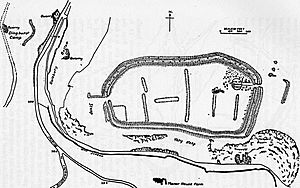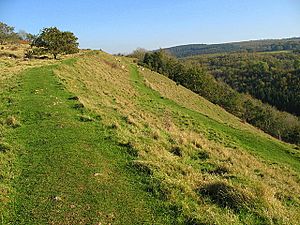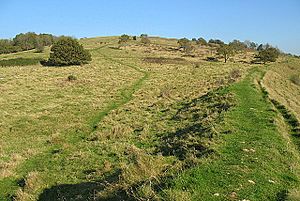Dolebury Warren facts for kids
Quick facts for kids Dolebury Warren |
|
|---|---|
| Native name Dolebury Camp | |
 |
|
| Location | Churchill, Somerset |
| Governing body | Avon Wildlife Trust |
| Owner | National Trust |
| Official name: Dolebury Camp | |
| Designated | 19 December 1929 |
| Reference no. | 1008184 |
| Lua error in Module:Location_map at line 420: attempt to index field 'wikibase' (a nil value). | |
Dolebury Warren, also called Dolebury Camp, is a special place in North Somerset, England. It covers about 90 hectares (that's like 220 football fields!). This area is known as a Site of Special Scientific Interest (SSSI) because it has unique plants and animals. It's also an ancient monument, meaning it holds important history.
Dolebury Warren sits on a limestone ridge, which is a long, narrow hill. Long ago, during the Iron Age, people built a hill fort here. They used it for protection and lived there even into the Roman times. The fort is quite large, covering about 9 hectares, and has strong walls around it.
Later, in the Middle Ages, the name Dolebury Warren came from its use as a rabbit warren. This was a place where people raised rabbits for food and fur. Today, the different types of soil and the landscape make it a home for many kinds of plants. These plants attract lots of insects, including beautiful butterflies.
Contents
What is Dolebury Warren Like?
Dolebury Warren is located on top of a Carboniferous Limestone ridge. This is a type of rock that was formed a very long time ago. The limestone here is visible because other layers of rock have worn away. The soil depth changes a lot across the site. This is due to the slopes and how much wind the area gets.
From Dolebury Warren, you can see far across the land. You can even see the Bristol Channel! The highest point is about 183 meters (600 feet) above sea level. The hill fort itself is a bit lower. This area is also the start of a walking path called the Limestone Link. This path is about 36 miles (58 kilometers) long.
The Ancient Hill Fort
The old fort at Dolebury covers about 9.1 hectares (22.5 acres). From here, you get amazing views of the countryside. The fort has two main walls on three sides. On the southern side, there is one strong wall because that side is very steep.
The fort is almost a rectangle shape. It is about 487 meters (1,600 feet) long from east to west. It is about 200 meters (650 feet) wide from north to south. The walls, called ramparts, are about 4 meters (13 feet) high and 12 meters (39 feet) wide. These walls were made of limestone and had a ditch outside them for extra protection. There was a special entrance on the west side. There was also a smaller area on the east side to protect the easier way in.
A Look at Dolebury's History
What Does the Name Mean?
The name Dolebury comes from old English words. Dwol means idol and beorg means hill. So, Dolebury means the idol hill.
Early Times
Many old items have been found at Dolebury Warren. These show that people lived here for a very long time.
- Some tools made of flint from the Stone Age have been found.
- Bronze spearheads and pottery from the Bronze Age were also discovered.
- Later, Roman pottery and coins were found.
There is clear proof that people lived here during the Iron Age. The fort's defenses and old farm fields date back to between 700 and 300 BCE. The hill fort was likely used until about 100 BCE. However, it might have been used again during Roman times and after. Some experts think there might have even been a Roman Temple inside the fort. Old aerial photos also show signs of ancient field systems.
The Medieval Rabbit Warren
In the Middle Ages, the old hill fort became a rabbit warren. This was a place where people raised rabbits. Rabbits were important for their meat and fur. Many warrens had banks or walls to keep the rabbits from escaping. If rabbits escaped, they could damage nearby farms.
The strong walls of the Iron Age fort made Dolebury an ideal place for a rabbit warren. You can still see signs of how people managed the rabbits. There are also signs of old farming methods, like ridge and furrow fields, from aerial photos. Some of these old features have been damaged by later digging. People might have dug here for lead, ochre (a type of clay), or calamine (a mineral).
In the 16th century, a writer named John Leland wrote about the site. By 1830, a three-story building, thought to be the warrener's house, was in ruins.
More Recent History
In the early 1800s, an archaeologist named John Skinner visited the site. Later, in 1872, Charles William Dymond surveyed it. Dolebury Warren was officially recognized as an ancient monument in 1929.
In 1935, a woman named Miss V. Wills bought Dolebury Camp. She did this to protect it from being built on. In 1952, Dolebury Warren was named a Site of Special Scientific Interest. Today, the National Trust owns most of the land. They bought it in 1983. The Avon Wildlife Trust helps to manage and care for the site.
Wildlife at Dolebury Warren
| Site of Special Scientific Interest | |
 |
|
| Area of Search | Avon |
|---|---|
| Interest | Biological |
| Area | 90.6 hectares (0.906 km2; 0.350 sq mi) |
| Notification | 1952 |
The fort and warren area is now covered in grassy slopes. These slopes are home to many different wild flowers and butterflies. Because the soil types vary, both acid-loving and lime-loving plants can grow here.
- Plants like kidney vetch, harebell, and woolly thistle grow well in the dry, stony soil.
- In more acidic areas, you can find heath bedstraw and wood sage.
- Higher up, there are plants like bell heather, western gorse, and common heather.
- Trees and shrubs include the wayfaring tree, guelder rose, whitebeam, privet, and dogwood.
Some rare plants found here are knotted pearlwort and slender bedstraw. Many types of butterflies also live at Dolebury Warren. These include the small blue, marbled white, dingy skipper, grizzled skipper, small pearl-bordered fritillary, and wall brown.
Images for kids





